Alfama, Lisbon
Alfama is Lisbon’s oldest neighborhood, and possibly, its most lived-in neighborhood. Situated on a hillside that faces south, Alfama extends from the Castelo de São Jorge on the hilltop down to the cruise terminal and the bank of the Tejo River.
Alfama means “hot water,” or “springs” in Arabic, and had been a Moorish settlement until the 12th century. Once the Christians retook the area, they built churches all over the hillside, often on top of former Muslim sites.
The neighborhood was somewhat spared by the 1755 earthquake. After the quake, wealthier Lisboetas left the hillside largely to fishermen and the working poor.
By the 1980s, Alfama was largely populated by fishermen, dockworkers, laborers, and shopkeepers. In the 1980s, roughly 50% had plumbing, and less than half of the homes in the area were inhabited. This was due both to the decay of the area and an aging population.
Source: “Alfama; from degradation to rehabilitation: F Brandão Alves et al” https://www.researchgate.net/publication/256520756_Alfama_from_degradation_to_rehabilitation
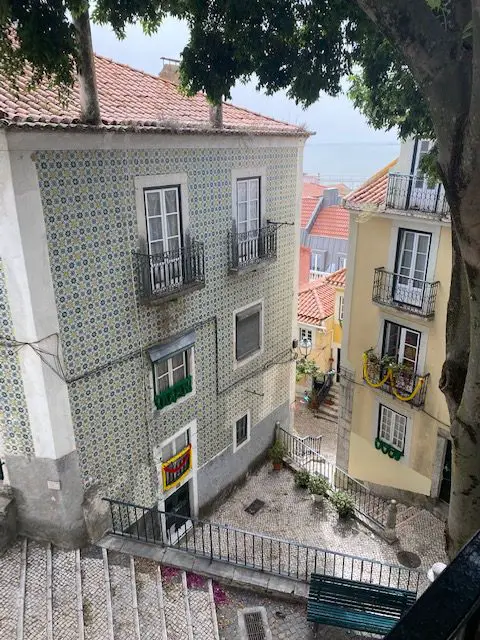
Today, the Alfama district is largely sought after for its historical buildings and stunning views. Much of the area has been renovated, and while some locals still live in the area, there are also a large number of vacation rentals in the neighborhood.
What is Alfama known for?
Aside from its medieval history, Alfama is known for its narrow streets and steep inclines. There are also many stairs in this neighborhood. Many of the narrow lanes are switchbacks and are not wide enough to accommodate cars.
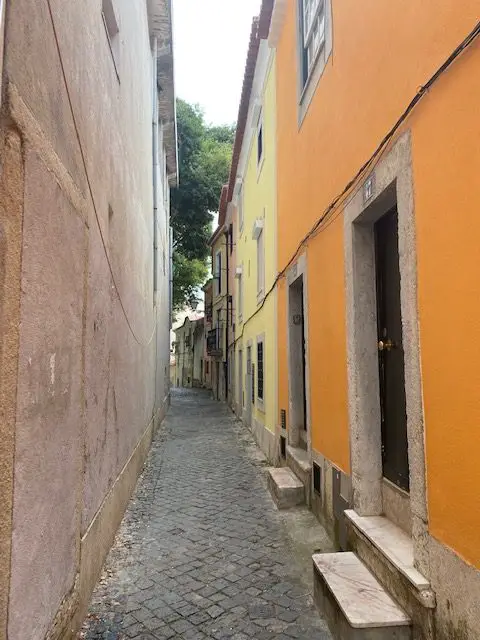
Many of the houses in the neighborhood feature tiny doors – perhaps four feet tall. A joke is that the purpose was to keep horses from entering the house.
More likely, it has to do with ventilation, with many of the houses having stairs on the interior leading to the first floor below ground level.
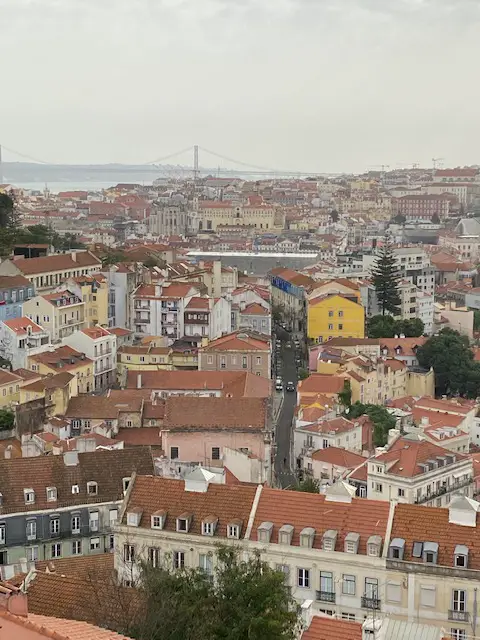
Alfama is known for having spectacular views – from the castle, you can see practically all of Lisbon.
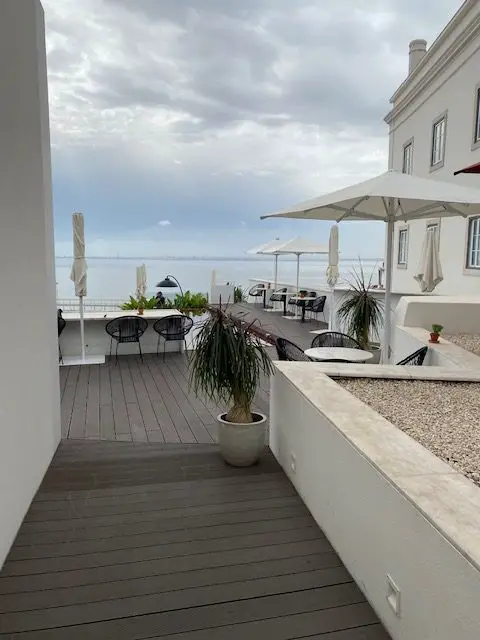
Below the castle, there are several public viewpoints (known as Miradouros), and some of the alleys and public terraces (as well as many of the hotels and rentals in the area) have stunning views.
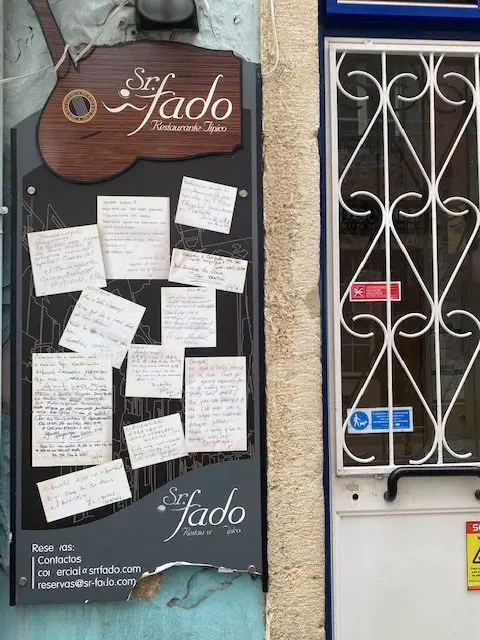
Alfama is known as the birthplace of Fado music. Fado is usually sung by one singer, often a woman accompanied by a Portuguese guitar. Both the sound and the lyrics are melancholy.
In some ways, it could be compared to the Blues. And just as the Blues are distinctly American, Fado is a distinctly Portuguese tradition.
There are plenty of restaurants in the area where you can take in a show. For more information, read my Everything you need to know about fado music in Lisbon
At the bottom of the Alfama neighborhood, you can also find the fantastic Fado Museum if you are interested in listening to recordings and exploring the history of this local tradition.
Alfama is known for street art. Look for Vhil’s portrait of Amália Rodrigues near the Miradouro das Portas do Sol.
Artist André Saraiva has a colorful mosaic with some 52,000 tiles in Santa Clara, near the Feira da Ladra flea market.
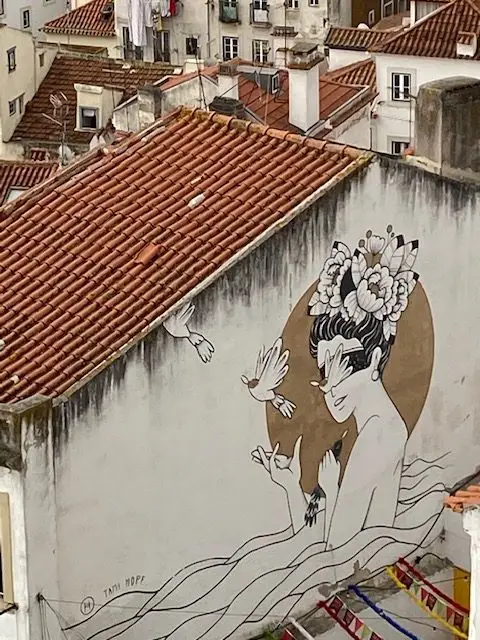
At the Miradouro do Sol you will also see Brazilian artist Tami Hopf’s mural “Lisa.”
As you wander the back alleys of Alfama, you will come across portraits of some of the neighborhood’s elderly residents. The 40 works scattered throughout the neighborhood were done by British artist Camilla Watson as part of her project “Alma de Alfama” (Soul of Alfama.”
For more information: https://www.camillawatson.com/alma-de-alfamasoul-of-alfama
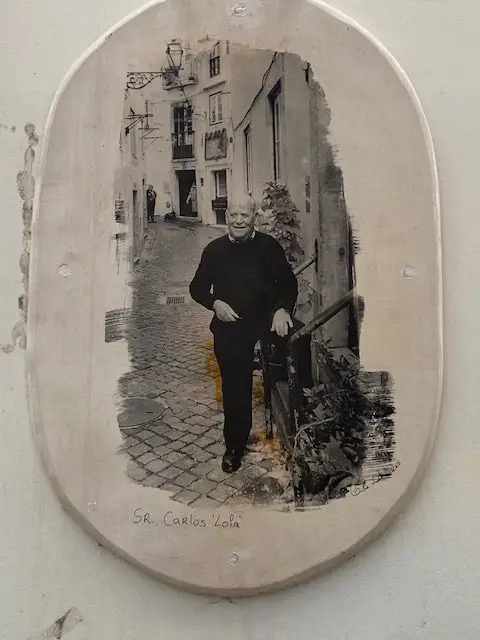
Alfama is also known for summertime celebrations. During the summer, residents of the neighborhood set up barbecues and tables in the lanes of Alfama and grill sausage, sardines, and sell beer. Alfama becomes a party.
St. Anthony was born in Alfama, right across from the cathedral. His feast day is June 12, and June 13 is the biggest night of the year in Lisbon. Dancing, eating, drinking, and music go all night long. There is a parade on the 13th on the central Avenida da Liberdade, and the different neighborhoods compete. There are block parties all over the city on June 13.
St. Anthony was also known as “The Matchmaker.” Each June, the city gifts a free, mass-wedding to local couples at the cathedral. These are the “Brides of Saint Anthony.”
How to get to Alfama
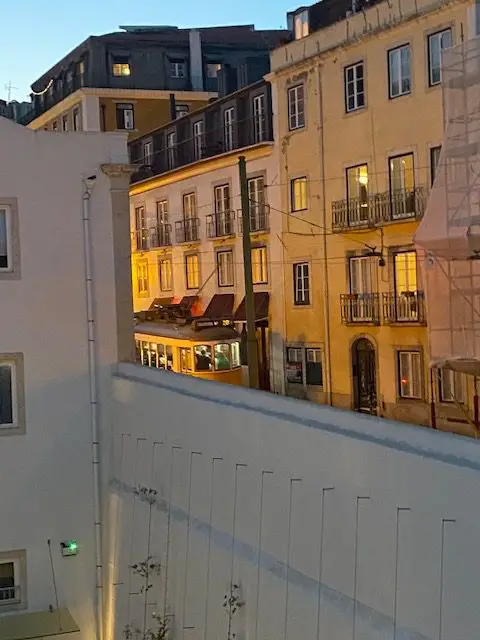
Tram 28E and Tram 12E both depart from Praça Martim Moniz. Tram 12E will have a much shorter line.
You could walk uphill, following the tram tracks as well.
Bus 737 departs from Praça da Figueira behind (east of) the Rossio Metro Station, and stops near the Miradouro das Portas do Sol before turning left and continuing uphill to the castle.
The two closest metro stations to Alfama (at the bottom of the hill, of course) are Martim Moniz (green line) in the center of town, northeast of Rossio Square, and Santa Apolonia (blue line) to the east of downtown located on the river.
Map of the Alfama District
What to do in Alfama
Castelo de São Jorge

Castelo São Jorge There has been a settlement on this hilltop since the 8th century. The Muslim Moors built a castle here in 1050 AD. Christian knights under Afonso Henriques took the castle back in 1147.
Castelo de São Jorge is open during the following times: November 1 – February 28 open 9 am – 7 pm. Hours extend until 9 pm during the warmer months. Admission is 10€. Seniors pay 8.50€. Children under 12 are free. The castle is one of only a few sites in Lisbon that are not discounted with a Lisboa Card.
Pastelaria Santo António

Rua do Milagre de Santo António, 10.
Turn right as you exit the castle and head downhill. Pastelaria Santo Antonio lies straight ahead in a beautifully tiled building. This bakery won Best Pastel de Nata in Lisbon in 2019. In my opinion, the gooiest (and possibly best pastel de nata) in the city as well. These delicacies sell for 1.20€ each.
Hours: Open until 7 pm.
Miradouro das Portas do Sol viewpoint
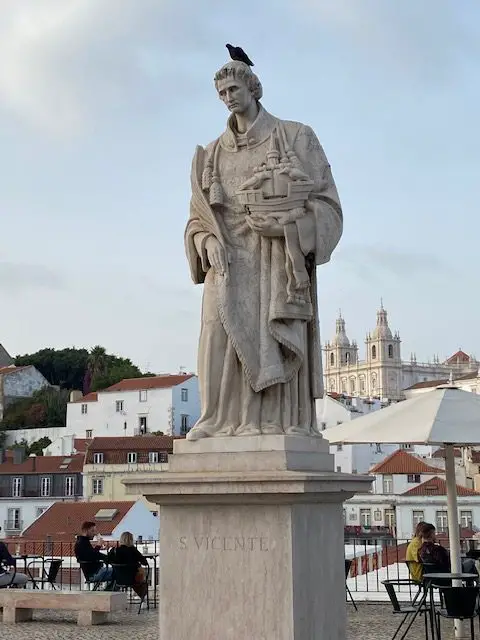
The miradouro das Portos do Sol is one of the best scenic viewpoints in Lisbon. There is a large plaza with a kiosk, and a separate cafe on a lower level. You may encounter street musicians performing near the statue of St. Vincent. It’s a great place to people-watch, but also to check out Alfama and the Tejo River.
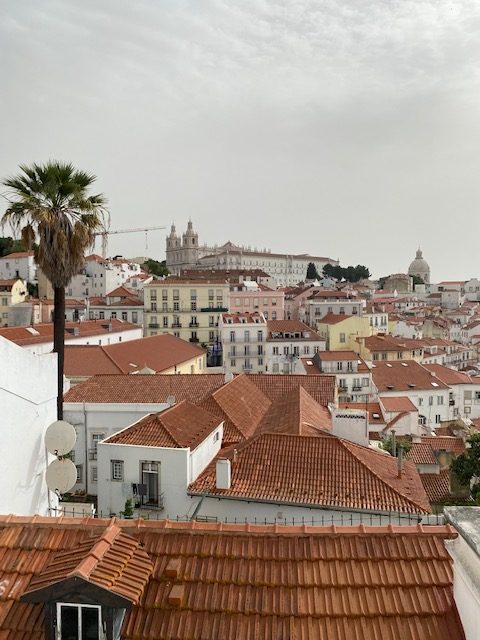
Alexandre Farto (VHILS) Portrait of Amália Rodrigues
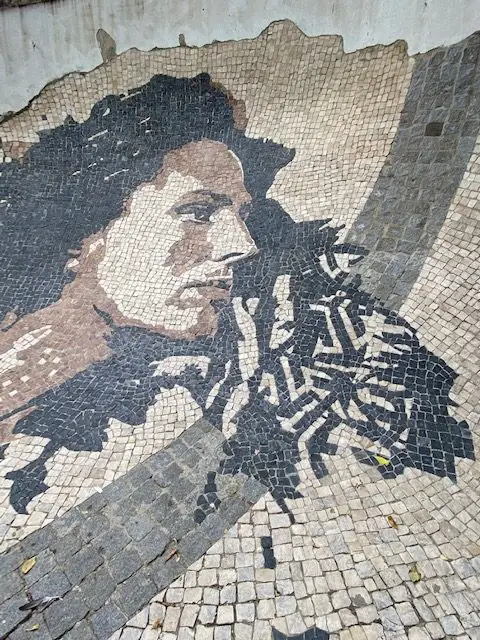
Just uphill from the Miradouro das Portas do Sol viewpoint, on the opposite side of the street, you will see a bus stop. Tucked in a corner behind the bus stop, artist Alexandre Farto (aka VHILS) has left this beautiful black and white mosaic entitled “Calçada” (pavement or sidewalk in Portuguese).
Using the classically Portuguese art form, this modern artist created a portrait of local Fado legend Amália Rodrigues.
Miradouro da Santa Luzia Viewpoint
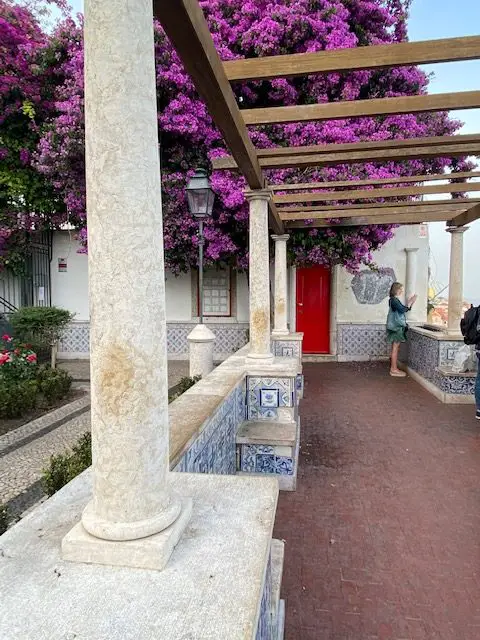
Practically next door to the Miradouro das Portas do Sol is the Miradouro de Santa Luzia viewpoint. It is one of the prettiest spots in Lisbon. The colors are amazing. The white chapel, the purple bougainvillea, the green vines on the arbor, the blue and white azulejo tile, the sky, the roofs, the water.
Aljube Museum of the Resistance
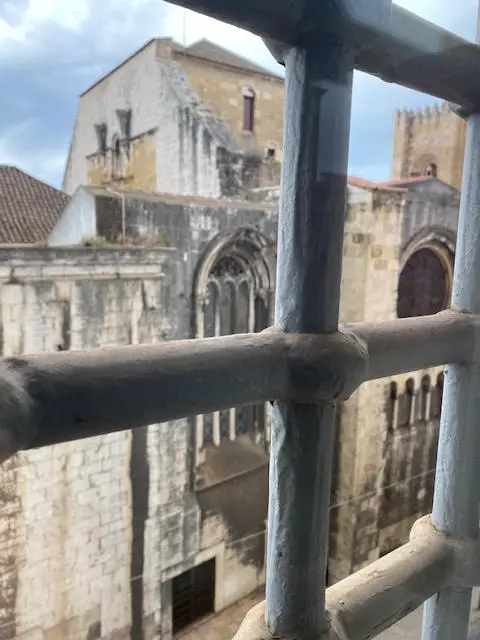
Rua Augusta Rosa, 42. Across from the cathedral
In a neighborhood full of medieval history, this museum focuses on the history of Portugal in the 20th century. The museum tells the story of the Estado Novo and the regime of the dictator Juan António de Salazar that lasted most of the 20th century. It also documents how the regime was overthrown in the Carnation Revolution.
As it turns out, the museum building, right across the street from the Lisbon Cathedral was one of Portugal’s largest prisons during the Salazar dictatorship.
Visitors can imagine what it was like to sit in a tiny cell as a political prisoner and look out at the cathedral.
This is a great stop for history buffs and is a treasury of information. Not all visitors to Lisbon will appreciate that, but if history is your thing – have fun! Admission is only 3€.
For more information, read my Aljube Museum – learn about Portugal in the 20th century
Lisbon Sé Cathedral
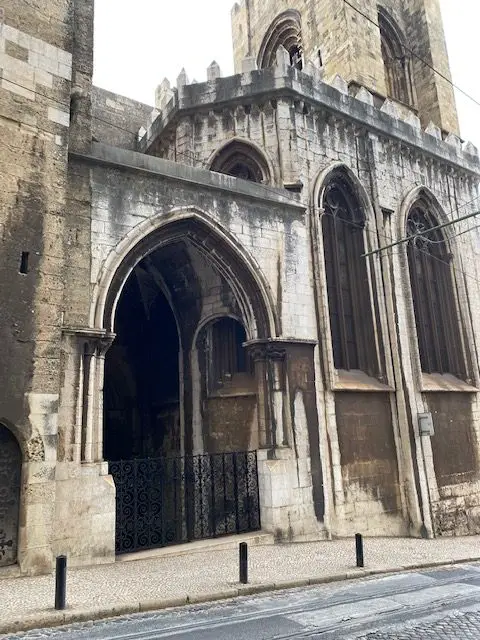
This church was built on top of a mosque in 1147, not long after the hill was taken from the Moors. The cathedral is known as Sé – the seat of the bishop. The fortress-like church easily withstood the 1755 earthquake. It is open daily from 9 am – 7 pm. Read my Lisbon Cathedral | All you need to know before you go – lisbontravelideas.com
Igreja de Santo António Church
Directly across the street from the Lisbon Cathedral and the Largo do Sé, this church was built on the spot where St. Anthony was born and lived as a child.
He was baptized in the cathedral, and attended church across the street.
He eventually became a monk in the Alfama monastery that would later become known as São Vicente de Fora Monastery.
In the church make sure to wander down the hall to your left and see the shrines dedicated to St. Anthony and the downstairs chapel where Pope John Paul II prayed. To learn more about St. Anthony Church, read my article , https://lisbontravelideas.com/2023/01/igreja-de-santo-antonio-church-in-lisbon-a-quick-guide
Museu do Teatro Romano (Roman Theatre Museum)
Rua de Sao Memede, 3A
In the 1st century AD, the Romans controlled this area, and they called it Olissipo. This was the site of the 4000-seat Roman Theatre.
The museum is part of the Museu de Lisboa.
Closed Mondays. Open Tuesday – Sunday from 10 am – 6 pm.
Casa dos Bicos
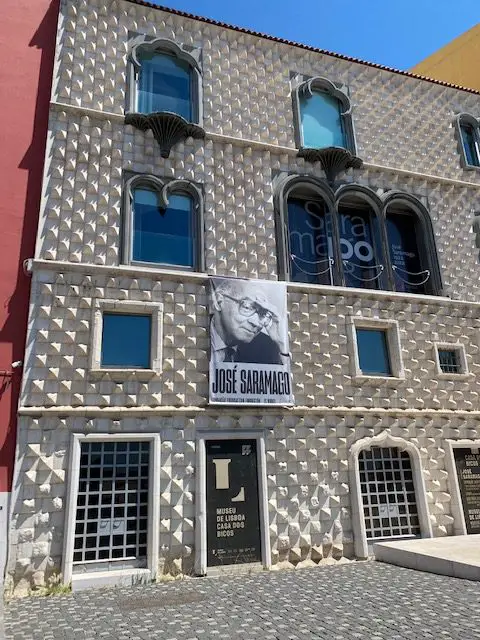
Rua dos Bacalhoeiros, 10
This house is famous for its Italian-inspired façade of diamond-shaped stones. Today the mansion houses the personal library of the Nobel Prize-winner for Literature in 1998, José Saramago, one of Portugal’s greatest authors.
It also houses an exhibition about his life and work.
Outside, under an olive tree, lie his ashes. The house was built in 1523 by Afonso de
Albuquerque, the Portuguese viceroy of India.
Museu do Fado / Fado Museum
Largo do Chafariz de Dentro, 1
Hours: Closed Mondays. Tuesdays – Sundays, 10 am – 6 pm. Last entry is at 5:30. Closed January 1, May 1, 24, 25, and 31 of December. Tickets: 5€, Seniors 4.30€, Ages 13-25: 2.50€, Under 12 free.
São Vicente de Fora Monastery and Church
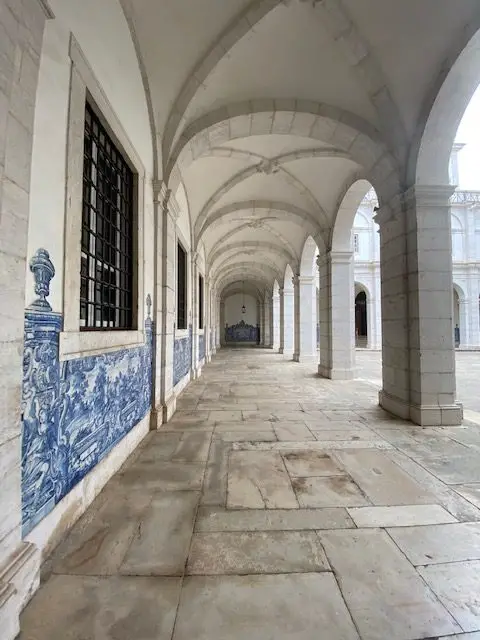
The Mosteiro de São Vicente de Fora (Monastery of St. Vincent Outside of the Town Gate) was originally built in the 12th century, not long after the Christian reconquest of Lisbon.
A glass floor in the sacristy reveals what are believed to be graves of some of the crusaders that died reclaiming the city.
Unfortunately, not much from the original structure remains today, other than the large cistern near the entryway.
Lisbon’s favorite son, St. Anthony lived here as a monk, and there is a chapel dedicated to him on the spot that was believed to be his living quarters.
One of the top reasons to visit is to enjoy the more than 100,000 blue and white azulejo tiles inside the monastery.
Another reason is to enjoy the rooftop balcony with its fantastic views of Lisbon and the river.
It is free to enter the church, but make sure you pay the €5 to enter the monastery, the cloisters, the crypt, the cistern, and explore the rooftop.
Children 12 and under are free. Ages 65 and over are free. Closed on Mondays.
National Pantheon / Santa Engracia
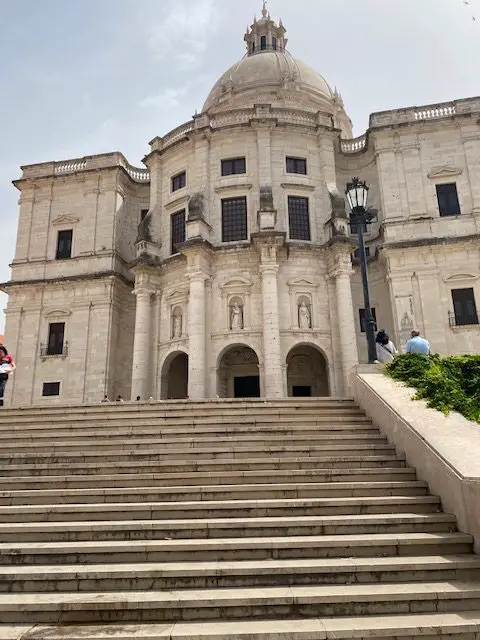
Campo de Santa Clara
This is the large domed building that you can see from across the river or from the Alfama district’s scenic viewpoints. Several of Portugal’s national heroes are buried here.
Admission is 5€. It is free if you have a Lisboa Card.
Closed on Mondays. Tuesdays and Saturdays are a good choice for a visit, because you can also go to the Feira da Ladra.
Feira da Ladra (Thieves Market)

Campo de Santa Clara
This 700-year-old flea market operates at Campo de Santa Clara. It is just outside of the National Pantheon (Santa Engracia). The flea market is held every Tuesday and Saturday morning.
Where to park in Alfama
Maybe you can find some on-street parking, or maybe your hotel has a few spots. Truth is, there isn’t a lot of parking around here. Try:
Estacionamento Pago Alfama, paid lot.
Estacionamento Chão de Loureiro
Rua de São Tome 88 Garage
Parking Campo de Cebolhas
Campo de Santa Clara
Cruise Ship Parking
Lodging in Alfama
This is Lisbon Hostel
Costa do Castelo,63
This hostel located in a 19th-century building has a large terrace overlooking the neighborhood. Breakfast is provided, but you are also welcome to get in on brunch, a Portuguese dinner, or Portuguese lessons. They organize free walking tours, yoga on the terrace, and trips to the beach.
A large single room with a twin bed, balcony, and a view Is $60 a night. Beds in four, six, or eight bedrooms start at $27 a night.
Breakfast is not included. Security lockers are available.
Laundry service and airport pick-up are also available.
Hotel Convento do Salvador
Rua do Salvador, 2B
This reasonably priced hotel is in a former convent directly below the Miradouro das Portas do Sol. From the viewpoint, you can actually take a short staircase down to the lane where the hotel is located.
A room with a queen bed can be had for as low as $100 per night. Although the building was once a convent, the rooms are both modern and comfortable.
The hotel is committed to sustainable practices, and a portion of each stay is donated to a local children’s community center.
Memmo Alfama
Travessa das Merceeiras, 27
Memmo Alfama has a rooftop pool and open-air lounge overlooking Alfama and the Tejo River.
Memmo Alfama is a quick walk from the Lisbon Cathedral and the Miradouro das Portas do Sol and Santa Luzia viewpoints.
A double room in this four-star hotel in the high season can be had for $218.
To book: https://www.booking.com/hotel/pt/memmo-alfama.en.html?aid=7930224&no_rooms=1&group_adults=2
Solar do Castelo
Rua das Cozinhas, 2
This Lisbon Heritage Hotel is the only hotel situated within the castle’s walls. This romantic boutique hotel in an 18th-century building occupies the former kitchen space of the Castelo de São Jorge.
The 14-square-meter Castelo room can be had for as low as $306 per night. Guests are provided a free bottle of port on arrival.
Palacete Chafariz del Rei
By Unlock Hotels
Travessa Chafariz del Rei, 6
Stay in a beautiful 19th-century mansion.
A deluxe suite with a river view, 646 square feet, air conditioning, and a queen bed can be had for around $350 per night.
To learn about other popular neighborhoods in Lisbon:
Lisbon’s downtown – Baixa: Everything you need to know
Bairro Alto – An overview of Lisbon’s most vibrant neighborhood
Lisbon’s historic Belém neighborhood | Everything you need to know
Avenida da Liberdade | Everything you need to know
Thank you for reading about Lisbon’s Alfama district. Prices may vary. If you purchase anything from a link in this article, I will receive a small commission. That would be great! Thank you for supporting my work.